Table of contents
- Laverda-Bimota conversion Fusion of two motorcycles
- love at first sight
- The iota was love at first sight
- TuV engineers wish them all the best
- The Bimota steering head as a trademark
- Suitable for country roads
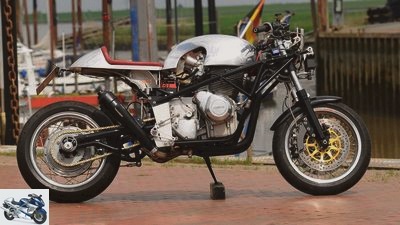
Fred Siemer
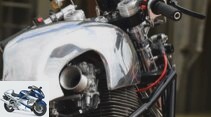

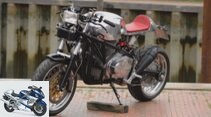
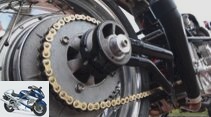
17th pictures
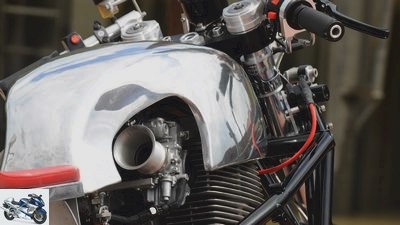
Fred Siemer
1/17
An East Frisian collector appreciates the three-cylinder Laverda just as much as special European chassis.
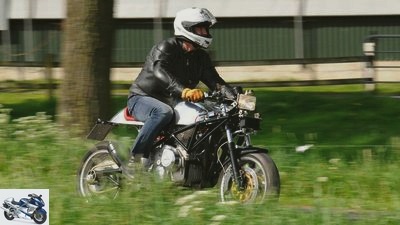
Fred Siemer
2/17
Long-time fan Karl Wiebesiek found out with his own creation how wonderfully easy it can be to sweep the country roads with a Laverda treble.
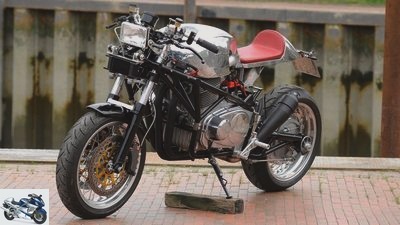
Fred Siemer
3/17
The swing arm of a fairly up-to-date Benelli TNT was chosen as the rear wheel guide because its axle width fits the Bimota layout perfectly.
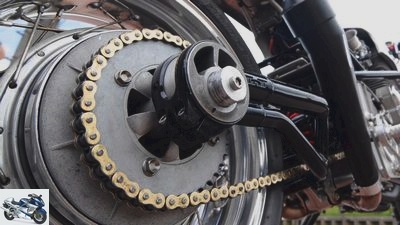
Fred Siemer
4/17
At the rear, the beautifully shaped swing arm of a modern Benelli TNT guides the 17-inch spoked wheel.
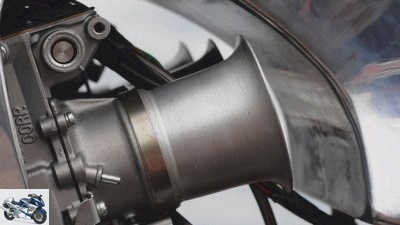
Fred Siemer
5/17
In the small section of the aluminum tank, three Mikuni flat slide carburetors snap for combustion air.

Fred Siemer
6/17
To the left and right of the cylinder head there would still be room in the Bimota frame, but it protrudes quite a bit upwards.
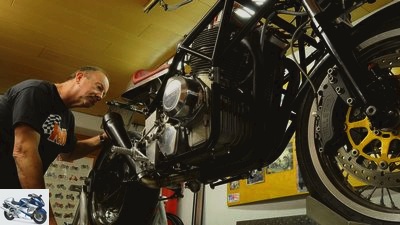
Fred Siemer
7/17
The lugged joists of the lightweight tubular space frame lie close to the engine block.
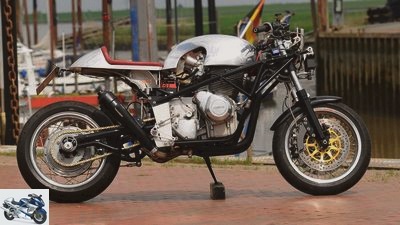
Fred Siemer
8/17
Also nicely done is the centrally aligned manifold system.

Fred Siemer
9/17
The special Bimota steering head also allows straight and therefore more rigid pipe connections in this area.
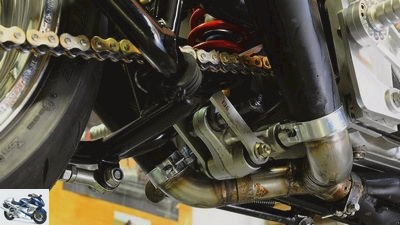
Fred Siemer
10/17
Karl Wiebesiek was able to connect the lever of the central spring strut to the lower engine mount at the front.
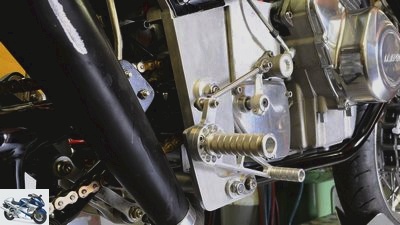
Fred Siemer
11/17
The production of the multifunctional light metal mounting plates was like a tricky brain teaser.
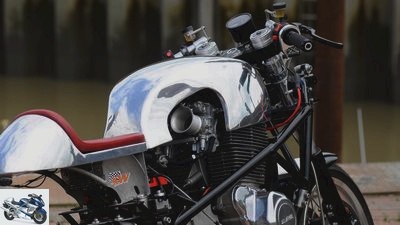
Fred Siemer
12/17
That’s what you call radiance.
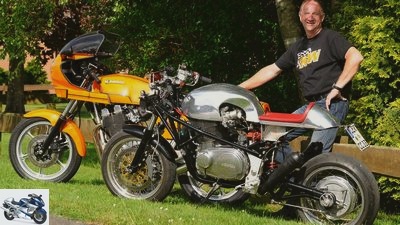
Fred Siemer
13/17
Can also be classic: Karl Wiebesiek has already restored several Laverda triples.

Fred Siemer
14/17
Eleven liters fit into this self-conceived and finally made by tank builder Friedhelm Lammers in Wietmarschen.

Fred Siemer
15/17
Engine: transversely installed in-line three-cylinder four-stroke engine.
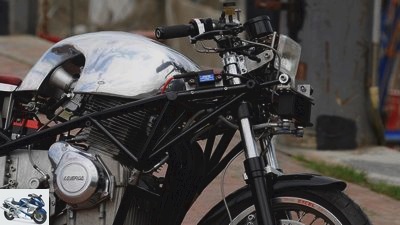
Fred Siemer
16/17
The unsuitable upside-down fork replaces a Marzocchi M1R with a robust stabilizer above the stanchions, which was also at work in Ducatis Paso or Bimotas SB5.
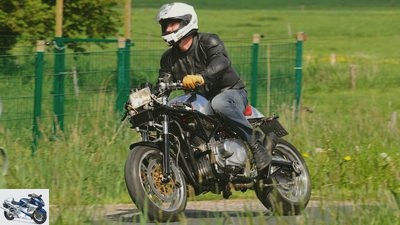
Fred Siemer
17/17
The tall 57-year-old designed the sitting position in a relaxed manner. Suitable for country roads, and that’s where his entire machine cuts a really good figure.
Laverda Bimota – merger of two motorcycles
Laverda-Bimota conversion
Fusion of two motorcycles
Content of
An East Frisian collector appreciates the three-cylinder Laverda just as much as special European chassis. Then he dared to try to combine his two hobbies in one motorcycle. The result was just as idiosyncratic as it was perfect and even surprised the builder.
December 29, 2019
Really large pots determine his life, and this statement does not refer to Karl Wiebesiek’s over 35-year crush for the heavyweight three-cylinder from Laverda. But on his everyday professional life in an up-and-coming East Frisian shipping company: As a technical shipping company inspector, Karl takes care of the regular maintenance of the ships, organizes mechanics, parts, berths and docks. When engine overhauls are pending, he basically has to book a crane, and his Breganzer triplets actually make it easy for him.
love at first sight
Besides, that’s the way it is that he likes these things. Not all, no, but all with the 180-degree engine with a strong character, in which the outer pistons – unlike the slightly more gentle 120-degree engine offered last – race up and down in parallel. His first Jota also carries a 1000 in this configuration, bought in 1982 on the other side of the river from Yamaha and Laverda dealer Eddy Uden in Neukamperfehn, driven a lot, never given away.
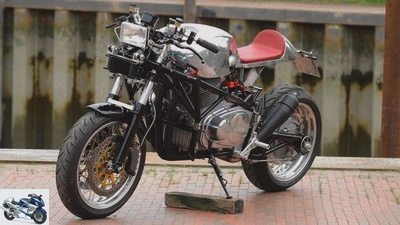
Fred Siemer
The swing arm of a fairly recent Benelli TNT was chosen as the rear wheel guide because its axle width fits the Bimota layout perfectly.
“It was love at first sight,” winks Karl, and he still puzzles today why he didn’t choose one of the great Japanese women back then. In any case, the affection grew so much that soon more Laverda triples were parked in his garage. However, this did not prevent him from following the technical course of the world, and so the passionate high-speed driver soon found himself in the wake of European special chassis. In 1990 the first Egli moved in with him, then a second, soon followed by a Bimota KB 1 to 3, a Martin with a BMW K 100 engine and so on.
The iota was love at first sight
Some of these sweethearts were only given one guest appearance, because Karl didn’t chained a ducat donkey next to his workbench. But over the years he has always maintained a very good balance between screwdriving, peeping and vehicles. In the interest of this balanced mixture, he couldn’t say no when he saw a Bimota HB2 frame lying around at the exhaust manufacturer MAB in Itzehoe. Between 1981 and 1984 the Riminese had built the engine of the legendary Honda CB 900 Bol d‘Or into this concise tubular construction, and something like that could easily be found anywhere. Karl thought as he grabbed it and then packed it up. On the way home, however, a much bolder plan germinated, and who knows, perhaps that Harris-Laverda – also fitted with a tubular frame – was partly to blame that he had once owned and then given up again. When his home port at the mouth of the Ems came into view, it was certain that Karl would create the first Laverda-Bimota. In order to finally provide proof that Messrs. Bianchi, Mori and Tamburini had wrongly spurned the northern Italian threesome. BMW, Ducati, all the Japanese had just refined them Laverda Not.
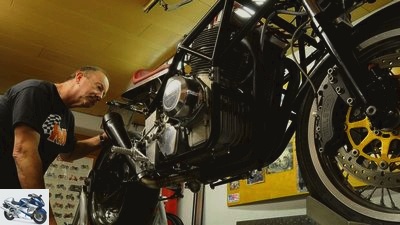
Fred Siemer
The lugged joists of the lightweight tubular space frame lie close to the engine block.
Of course, the high-end screwdriver knew for a long time that the engine block dimensions of the triple from Breganze and the four from Hamamatsu are not that far apart. Nevertheless, he got himself an empty engine first. “You don’t just lift the complete Laverda threesome into a chassis.” So like with the big pots …? Regardless, equipped in this way, it quickly became apparent that the aluminum plates that close the Bimota HB2 frame to the rear, accommodate the swing arm and of course also support the engine, would be a real challenge. To make matters worse, the tubes of the frame joists that are lugged on at the front also flow into these things – a lot of functions for two milled parts, very high demands on their perfection. Karl Wiebesiek therefore initially worked with wooden models, fortunately a few people who can also do small things were found for the end product in the orbit of large pots. Even perfect, “but it was a bit fiddly”.
TuV engineers wish them all the best
The swing arm of a fairly recent Benelli TNT was chosen as the rear wheel guide because its axle width fits the Bimota layout perfectly. The HB2 had already had a central suspension with deflection, that of the TNT swing arm could be simply connected to the lower motor bracket after some thought and re-knitting. Done, the technical framework for this truly daring conversion was in place. “Then I knew: it would work,” reports Karl about the end of this first construction phase and takes a deep breath in memory. Everything else would work out. But also cost money and time, which is why he drove up to the TuV for the first time at this point.
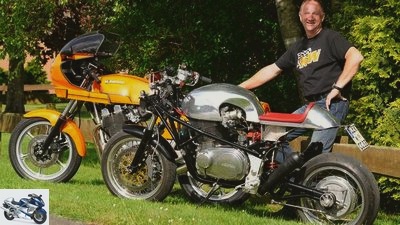
Fred Siemer
Can also be classic: Karl Wiebesiek has already restored several Laverda triples.
There the plan to use a modern wheel guide also fell apart: “With an upside-down fork, there was no real steering angle possible.” But basically the TuV engineers wished them all the best. Perhaps because they were knowledgeable about history and remembered that Bimota had designed the trellis tube of the HB2 as a universal frame, into which any conceivable four-cylinder could pull in simply through other mounting plates and beams. This is what happened with the KB2, which was presented almost at the same time, with the drilled-out 550 Kawasaki engine. According to the company’s philosophy, the steering head and swing arm bearings should be connected as straight a path as possible, and with the straightest possible tubes. As a result, the pipes run around the outside of the engine. And so that you don’t have to strive in a rapid arc to a conventional steering head in front of the engine, Bimota integrates it. Which incidentally brings less weight than a steering head held on one side, which requires a lot of gusset plates for stabilization. Only mechanics had to endure the getting used to, because normally the frame tubes pushed through to the front served as a holder for any full cladding.
The Bimota steering head as a trademark
Only not with Karl. To this day, he is so convinced of this construction that he wanted to see it. And show. So no disguise that has been adapted in any way. His LB1 would look out into the world naked and unabashed. This daring idea logically determined all further design work: Those who start radically technically at the front must not make a bombastic exit at the back. Which is why Karl is proud of its almost floating hump construction, simply screwed onto the top of the Bimota frame. But one after anonther. The unsuitable upside-down fork replaces a Marzocchi M1R with a robust stabilizer above the stanchions, which was also at work in Ducatis Paso or Bimotas SB5. The Bimota HB2 was one of the pioneers of the 16-inch shaft over 35 years ago, but you don’t have to imitate all the stupid things. At Karl Wiebesiek, 17-inch wheels turn at the front and back. The former comes from a Ducati Paul Smart Replica, the latter consists of a Laverda drum and a Borrani high-shoulder rim. Both are fitted with modern, but by no means over-wide tires. The front wheel is decelerated by a system made up of two billet six-piston pliers, and it really works when the splendid Brembo brake pump on the right-hand side of the handlebar is activated.
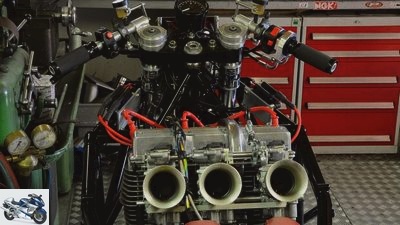
Fred Siemer
To the left and right of the cylinder head there would still be room in the Bimota frame, but it protrudes quite a bit upwards.
On the other hand, the LSL handlebar half also has a Brembo armature for the Laverda multi-plate clutch, which has been converted to hydraulics because it is otherwise exhausting. The second, also widespread change to the internally standard engine would be the electronic Witt ignition. The elbows come from the Laverda accessories and were welded onto a three-in-two system, the boldly towering end pots are shortened examples of a Laverda Jota. The newly knitted electrics were linked to a Moto gadget box. “It saves”, says Karl, “some components, but you have to think about it.” What’s missing? Of course, something is missing: the filigree works of art in the tank cutout are a battery made up of three Mikuni flat slide carburetors. Karl is absolutely convinced of this, but the light metal tank does not have its distinctive notch to make this conviction visible. He laughs: “The Laverda engine is really high. It looks up four or five centimeters farther out over the frame than Honda’s. ”A classic arrangement would have built far into the sky, and that’s why Karl now kneels with the intake funnels if he wants to. Eleven liters fit into this self-conceived tank sculpture, which was finally made by tank builder Friedhelm Lammers in Wietmarschen. “Enough. I don’t want to go on vacation with you … ”But go, that is.
Suitable for country roads
The tall 57-year-old designed the sitting position in a relaxed manner. Suitable for country roads, and that’s where his entire machine cuts a really good figure. “You could say: Driving Laverda made easy.” This is what it sounds like when East Frisians go into raptures. Or if you want to avoid self-praise, but Karl can’t help but praise the handling of his LB1. Of course, a weight saving of 30 kilos compared to an original weighing at least 240 kilos plays a role. But also the much-praised geometry of the Bimota chassis. The long swing arm, by the way, does not have a negative impact. “Why then?” Asks Karl, “everyone has today.” That’s right, and the wheelbase of 1,510 millimeters is not out of the ordinary either. “It only works that way because I made the bike very short around the top. The small tank, the short hump. “No, no, it fits, and so the only improvement request remains a Wilbers shock absorber. The damping of the strut taken over with the Benelli swingarm is not sufficient. That can be done.
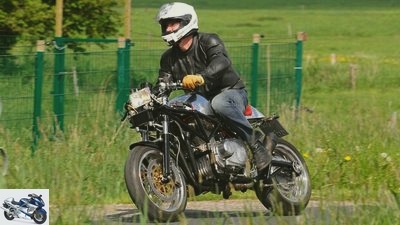
Fred Siemer
The tall 57-year-old designed the sitting position in a relaxed manner.
Especially since the TuV tests are now well on their way. Soon Karl will be allowed to show his work on the street without a red number. In February he had to confine himself to one exhibition hall: The man is well connected and, with his Laverda classics, the makers of the Bremen Classic Motorshow are always welcome. Then he simply put his LB1 down next to Jota and 3C. “Let’s hear what people say.” Whether someone is upset about the oil cooler anchored to the outermost frame arm or about the Bosch headlight above it. Above all, enjoy the recurring baffled question: What is it? The admiration turned into admiration just as regularly because the technical solutions found are convincing at first. Because everything tells of impeccable craftsmanship. Because you can see from this motorcycle that it shouldn’t be art for art’s sake. An excitement, yes, but made in a completely positive sense and on top of that by someone who can obviously also classically and is one of the keepers. In the end, however, Karl happily loaded his Laverda fleet back into the van. Incidentally, he likes to use a small cable winch for this. Because the triplets from Breganze are and will remain rather big pots.
Related articles
-
Laverda 650-750 purchase advice
Schermer 21 pictures Schermer 1/21 The Laverda as a used one. You can find out what to consider when buying in this photo show. Schermer 2/21 Has…
-
Bimota Tesi 1D 906 with wheel hub steering
duke counselor technology & future Bimota Tesi 1D 906 with wheel hub steering Bimota Tesi 1D 906 with wheel hub steering Ecstatic technology freaks all…
-
Motorcycle production at Bimota
Jahn counselor traffic & business Motorcycle production at Bimota This is how one of the smallest manufacturers in the world produces Motorcycle…
-
Kawasaki adapts Bimota technology: patent for stub axle steering
Kawasaki 6th pictures Kawasaki 1/6 Kawasaki has patented a steering knuckle system. Kawasaki 2/6 The Kawasaki system relies on a single-sided swing arm…
-
Laverda specialists Orange Cycle Team
Siemer 24 pictures Siemer 1/24 Siemer 2/24 Siemer 3/24 Siemer 4/24 Siemer 5/24 Siemer 6/24 Siemer 7/24 Siemer 8/24 Siemer 9/24 Siemer 10/24 Siemer 11/24…
-
Used motorcycles between 1000 and 4000 euros
archive counselor Used purchase Used motorcycles between 1000 and 4000 euros Advice on used bikes from 1000 to 4000 euros Bargain motorcycles It wasn’t…
-
Report: This is how Triumph produces motorcycles
triumph motorcycles Report: This is how Triumph produces motorcycles Report: This is how Triumph produces motorcycles Where and how are the two and three…
-
Second-hand advice: 125cc motorcycles
manufacturer counselor Used purchase Second-hand advice: 125cc motorcycles Second-hand advice: 125cc motorcycles Small bikes, great fun and all that at…
-
Unusual motorcycles from Ducati, BMW, Suzuki and Yamaha
Jahn 23 pictures Jahn 1/23 Ducati Diavel: The devil’s roast from Bologna surprised the motorcycle world, its success even Ducati. Jahn 2/23 Ducati Diavel…
-
MOTORCYCLE archive motorcycles The top ten motorcycles The top ten motorcycles The ten best sellers in 2005 These ten motorcycles are both an incentive…